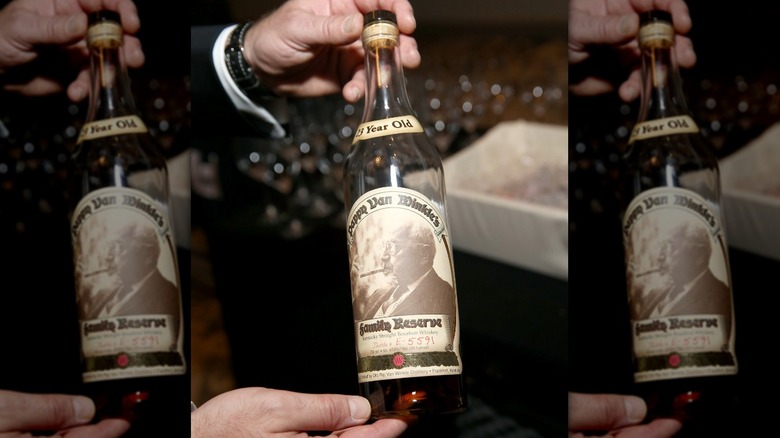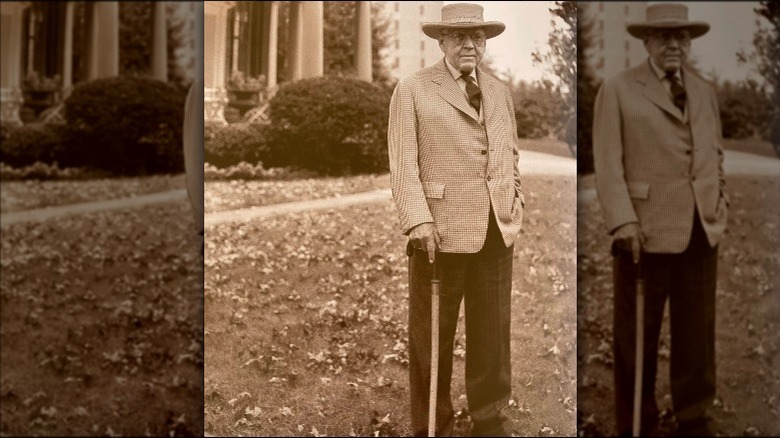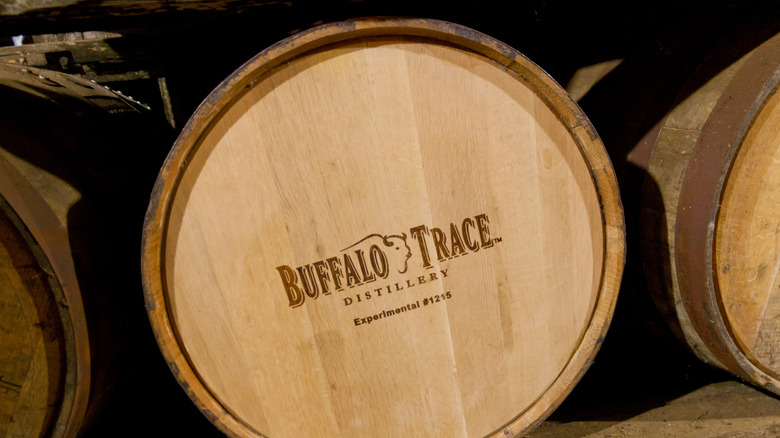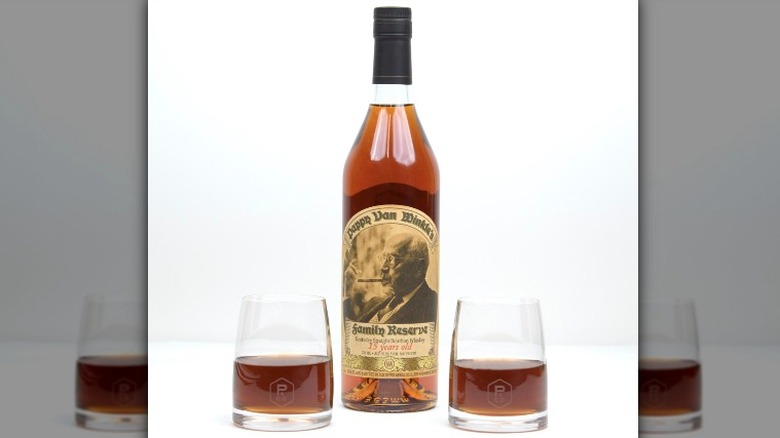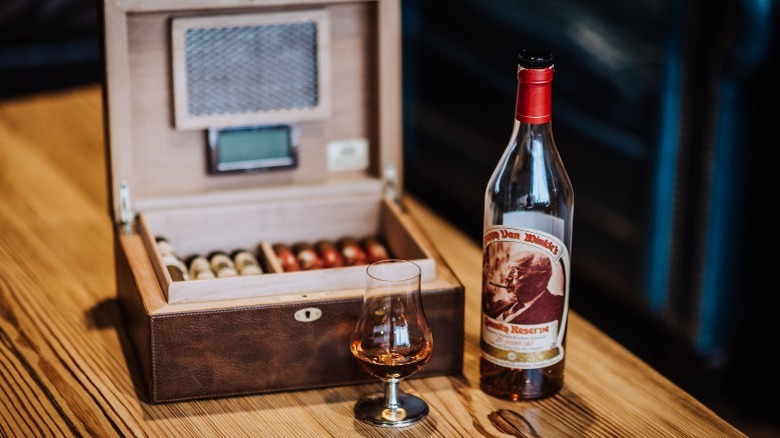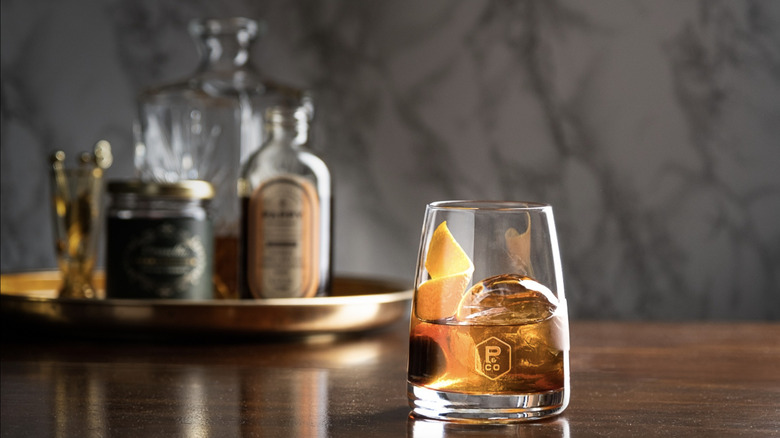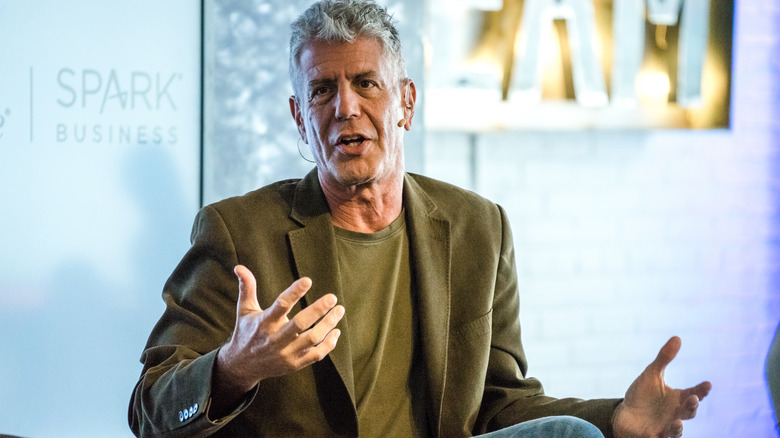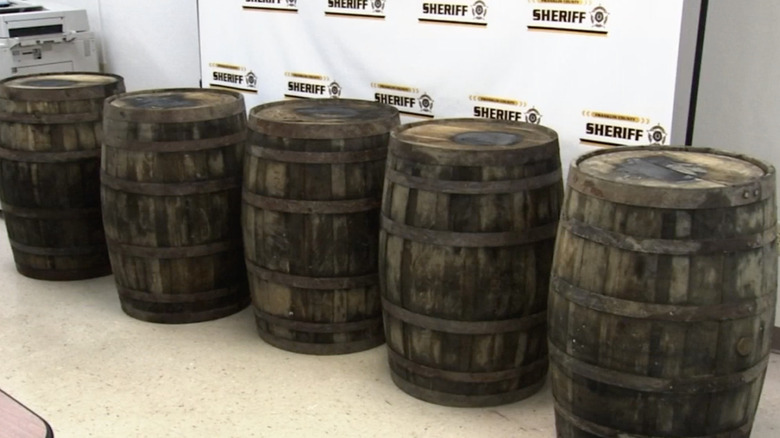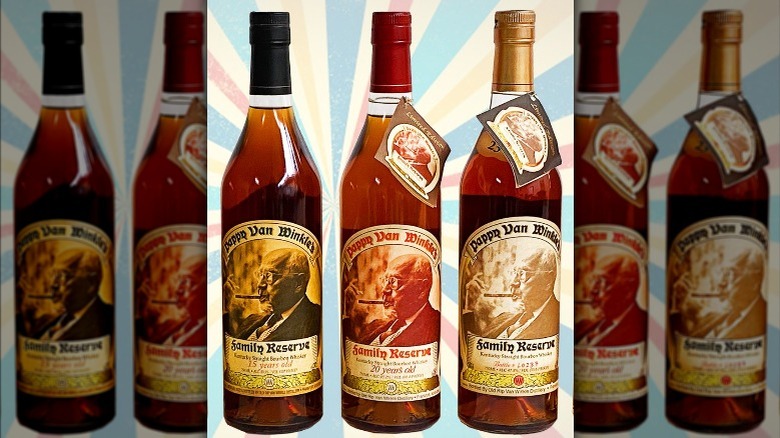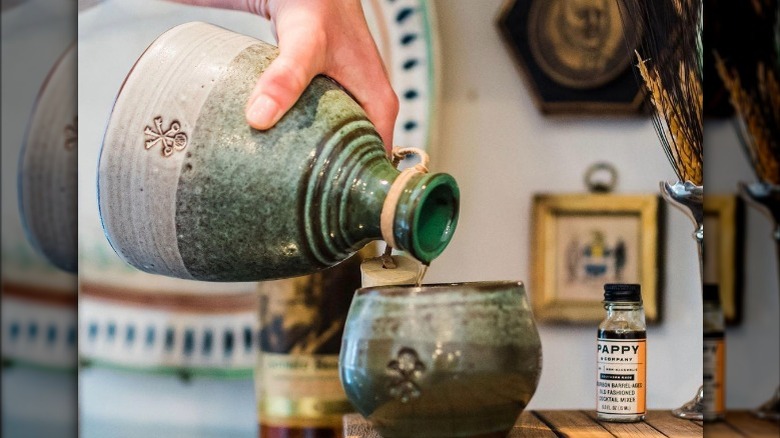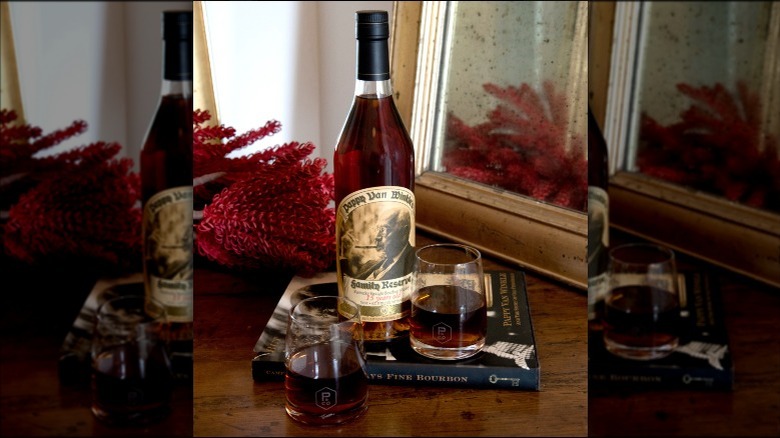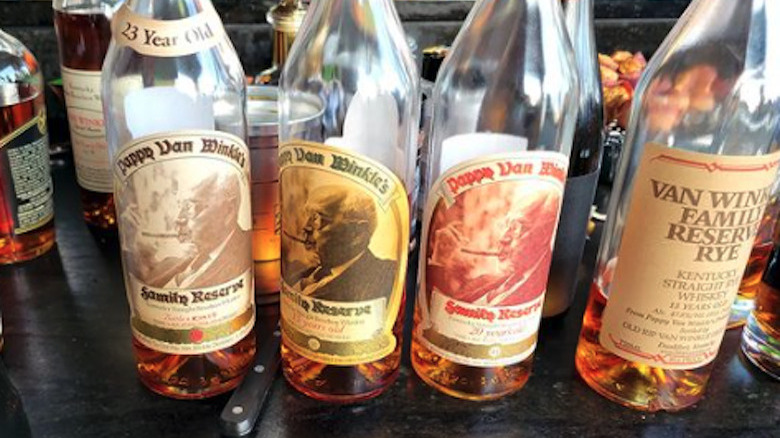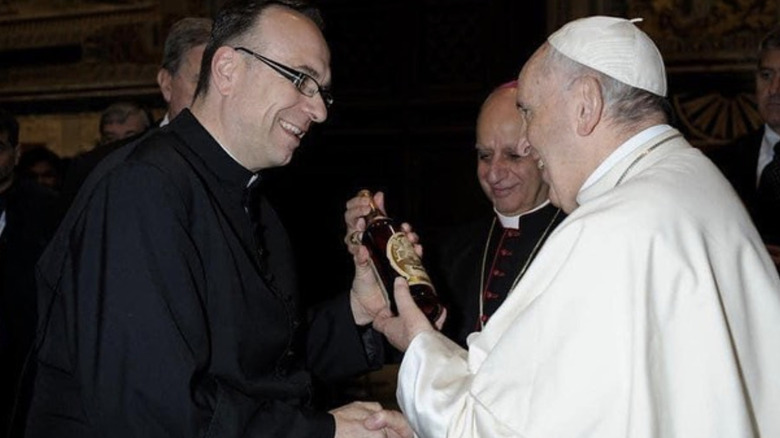The Untold Truth Of Pappy Van Winkle's Family Reserve
Pappy Van Winkle's Family Reserve whiskey is the stuff of legends. Aptly referred to as the unicorn of bourbons, the elusive drop is as hard to find as a needle in a haystack. Nevertheless, bourbon aficionados don't lose hope — they enter their names on waiting lists, buy lottery tickets, and as a last resort fork out thousands of dollars to buy a bottle of the amber elixir on the secondary market.
Pappy — as it's affectionately called — first hit liquor stores in 1994 with the release of 20-year-old bottles. The 23-year-old version of the bourbon whiskey followed suit in 1998. Finally, 15-year-old bottles of the iconic liquor arrived in stores in 2004. Initially available for under $100, over the years Pappy has gained the kind of cult following that's made reasonably-priced bottles of the liquor impossible to find (via Wine Enthusiast).
So what is it that sets Pappy apart from its kin? Firstly, the label is aged much longer than standard bourbon. And while like all other bourbons Pappy is made with corn, and its secondary grain is wheat rather than rye (via Chicago Bourbon). According to the Wine Enthusiast, it's this wheated recipe that makes Pappy such a sweet, smooth and accessible drop.
Whether you've been lucky enough to sample Pappy or you're still waiting for that golden opportunity, it pays to stay informed. Keep reading to find out what makes Pappy Van Winkle's Family Reserve so special.
Pappy was a real person
The man who appears on the label of Pappy Van Winkle's Family Reserve once said, "We make fine bourbon at a profit if we can, at a loss if we must, but always fine bourbon." Today, his name — Julian P. "Pappy" Van Winkle Sr. — is synonymous with some of the best bourbon in the world (via Buffalo Trace Distillery). And while Pappy was the mastermind behind Old Fitzgerald, the first bottle of Pappy Van Winkle's Family Reserve would only see the light of day 30 years after his death (via Whas 11).
Pappy started his career in the bourbon industry as a salesman for W.L. Weller in the late 1800s. He eventually purchased the business, as well as the Arthur Phillips Stitzel Distillery that produced liquor for Weller. In 1935, the two companies merged into the Stitzel-Weller Distillery. Pappy soon started producing smooth-tasting bourbon by adding wheat to the mash — something that has been viewed as his greatest contribution to modern bourbon (via Pappyland).
The Stitzel-Weller Distillery was sold in 1965 — a few years after Pappy's death — but not before the Van Winkle family secured the right to purchase the distillery's barrels. In 1972, Pappy's son, Julian Van Winkle Jr., founded the Old Rip Van Winkle brand and started bottling the barrels. After his death, his son Julian Van Winkle III, took over the enterprise, releasing the first Pappy Van Winkle's Family Reserve in 1994 with barrels sourced from Stitzel-Weller distillery (via Wine Enthusiast).
Pappy Van Winkle's Family Reserve is distilled by Buffalo Trace
After Stitzel-Weller closed shop in 1992, Julian Van Winkle III found himself in a dilemma. Since the distillery provided Julian with barrels for bottling Pappy, he was eventually going to run out of stock. In 2002, Buffalo Trace took over the job of distilling and aging Pappy to Julian's exact specification (via Wine Enthusiast). Today, the Pappy brand is still distilled under the Old Rip Van Winkle company name, which has bourbon produced under contract at Buffalo Trace (via Master of Malt).
While Buffalo Trace follows the old Van Winkle recipe, according to Aaron Goldfarb who writes for the Wine Enthusiast, there's no way that Buffalo Trace can produce the same bourbon as Stitzel-Weller. "It utilized different fermenters and stills, water sources, yeasts and aging locations," he writes.
According to Jeremy Repanich who was present when Julian tasted the first batch of Buffalo Trace's offering, the reception to the spirit was overwhelmingly positive. "When Julian's tasting, he's like, 'This isn't Stitzel-Weller, but it's really close.' He was really happy. Everybody did their jobs," Repanich writes in the Robb Report. Others haven't been quite as understanding. Aaron from the Wine Enthusiast writes, "While some connoisseurs thought it wasn't quite as good as it used to be, few thought it was inferior ... The cognoscenti still seeks out Stitzel-Weller Pappy, which sells for quite a bit more than Buffalo Trace bottles."
The label was propelled to stardom
Pappy Van Winkle didn't always have such a cult following. In fact, the bourbon only started gaining popularity after a Van Winkle sales representative submitted a 20-year-old bottle of Pappy Van Winkle's Family Reserve to the Beverage Testing Institute in 1997. And the alcohol authority was impressed — so much so that it awarded the liquor an unprecedented rating of 99 out of 100. At the time this was the highest score ever received by a bourbon, whiskey, or scotch from the institution (via Garden & Gun).
Interestingly, according to the Gear Patrol, the bottle of Pappy Van Winkle's Family Reserve submitted to the panel wasn't made with barrels from Stitzel-Weller. "According to Julian III, the bourbon inside that bottle had been purchased from Wild Turkey, who had acquired it themselves from a distillery called Old Boone," the article states. The jury is still out on this one.
Getting hold of Pappy Van Winkle's Family Reserve is next to impossible
The hype created by the Beverage Testing Institute's high score and the air of exclusivity that has grown around the liquor has made finding a bottle of Pappy a hefty task indeed. Not only is the bourbon aged 15, 20, and 23 years — much longer than conventional bourbons — it's also produced in limited quantities (via Chicago Bourbon). This seems more understandable when we consider that 94% of Pappy is lost to angel's share — or evaporation — over its production time (via Vinepair).
In total, only between 6,000 and 7,000 cases of Pappy are released each year. And while to some this may seem like a lot, Jim Beam releases a similar amount of spirits every 10 minutes (via Garden & Gun). Pappy Van Winkles are usually shipped to liquor stores twice per year — once in spring and once in fall — with the average allocation totaling six bottles per store. As such, it shouldn't come as a surprise that you're highly unlikely to see a Pappy on a store shelf since most of the bottles go straight to customers who have been on waiting lists for years.
It's one of the most expensive whiskeys in the world
Scarcity drives prices. And with Pappy Van Winkle's Family Reserve in such high demand, it's little surprise that the bottles are being traded for astronomical prices on the internet. The MSRP, or the manufacturer's suggested retail price, of 15-year-old Pappy Van Winkle's Family Reserve is $119.99, 20-year-old Pappy Van Winkle's Family Reserve is $199.99, and 23-year-old Pappy Van Winkle's Family Reserve is $299.99. However, if you think you'll ever score a bottle of the coveted bourbon at these prices, you're dreaming.
So what can you expect to pay for a bottle of Pappy Van Winkle on the secondary market? According to Better Marketing, bottles of Pappy can sell at markups of over 1000% a bottle. For example, a $299.99 bottle of 23-year-old Pappy Van Winkle's Family Reserve sells for around $3,600 on the internet. Bars that somehow score a bottle of the amber liquor, sell shots of the stuff at around $300 a pop.
Anthony Bourdain loved Pappy Van Winkle
There's little doubt that the celebrity chef, TV host, and writer Anthony Bourdain had his likes and dislikes. Pappy Van Winkle's Family Reserve definitely fell into the former category. In 2012, Bourdain drank Pappy when he visited Philadelphia in an episode of "The Layover," saying, "If God made bourbon, this is what he'd make" (via Wine Mag).
According to Esquire, Bourdain might have also been drinking the wheated bourbon on an episode of "No Reservations in Kentucky" when he was working for the Travel Channel. "In one segment, Bourdain, in his trademark voiceover, refused to identify the brand of bourbon he was sipping, lest it become even more difficult to acquire than it already was. But anyone who knew anything could clearly see the Pappy 20 label on the bottle," James Higdon writes for the publication.
It was at the center of a bourbon heist
With the bourbon virtually impossible to find in stores, one former Buffalo Trace employee (along with numerous accomplices) decided to take matters into his own hands. It's been alleged that between 2008 and 2015, the thirsty ring stole cases upon cases of Pappy Van Winkle from a Buffalo Trace Distillery in Frankfort, as well as bourbon from Wild Turkey distilleries (via CNBC). Gilbert "Toby" Curtsinger, who apparently boasted that he "always had 20 cases of Pappy on hand in his basement" pleaded guilty to the theft in 2018 (via Thrillist). He was later sentenced to 15 years in prison but released a month later since he was a first-time offender who wasn't deemed a threat to society (via Esquire).
Affectionately referred to as "Pappygate," the theft is examined in a new documentary series called "Heist," which debuts on July 14, 2022. More specifically, the Pappy heist is depicted in episodes five and six entitled "The Bourbon King." While Curtsinger appears in the doc, Buffalo Trace Distillery didn't take part in the filming (via Kentucky.com).
The Pappy Tracker app used to be a thing
Realizing that getting hold of Pappy Van Winkle was a little like squeezing blood from a stone, in 2013 Kyle Buza created the Pappy Tracker — an app to help users locate bottles of Pappy Van Winkle. "In some cases, [store owners] just flat-out lie to you about when it's coming out. And there are stories where people tell you they don't have it, but then you have someone else go in and ask in a different way and they give you a bottle. It's so frustrating, that whole process," Kyle once complained to the Las Vegas Weekly.
Pappy Tracker gathered information about Pappy Van Winkle bottles from social media including Instagram and Twitter. The app alerted users each time somebody posted a text or a photo about the possible sightings of the spirit in stores. Whether Pappy Tracker worked or not is unclear. Perhaps it's the latter since the app seems to be no longer available.
There is a Pappy lifestyle brand
Pappy Van Winkle fans who have never gotten the chance to taste the bourbon can console themselves with a Pappy T-shirt, cap, or some other branded gear. Set up by Julian's triplet daughters — Carrie, Louise, and Chenault — in 2013, Pappy & Co is the brainchild of the fourth generation in the Pappy bourbon line. Starting with basics such as branded hats and barware, the sisters gradually expanded their inventory. Today, Pappy & Co is a lifestyle brand that sells merchandise as varied as cigars and ceramics. "We've grown our brand by making and selling things that we use, or wear or want in our lives, inspired by our family's bourbon heritage and traditions," Carrie Greener says (via American Whiskey Brand).
All Pappy & Co merchandise draws its roots from the Van Winkle family's craft. As such, many of the products bear the brand's distinctive three-key logo inspired by the sign of five keys that once graced the door of the Stitzel-Weller distillery. "It was the perfect icon to really think about when we started our brand. And there are three of us sisters, and so we wanted to do something that was current and innovative and modern and showed that we were taking something old and making it new in our own way," Carrie says (via Forbes).
Lotteries give whiskey lovers the chance to buy a bottle
Although in theory, Pappy Van Winkle's Family Reserve comes with price tags that aren't entirely unaffordable, the label's scarcity (as we've mentioned) means that finding these reasonably-priced bottles is next to impossible. And buying Pappy bottles on the secondary market is a completely different story since you can expect to pay thousands of dollars for a bottle that would normally set you back between $100 and $200. Luckily, there is another way bourbon-enthusiasts can score a bottle of the amber spirit — by winning a lottery (via Whiskey Reviewer).
State governments in Pennsylvania, Ohio, and Virginia hold regular lotteries that give whiskey aficionados a chance to buy a bottle of Pappy. For example, in January 2022, a lottery held by the Pennsylvania Liquor Control Board gave individual participants the opportunity to buy one of 31 bottles of Pappy Van Winkle's Family Reserve 23 Year Old for $399.99, one of 70 bottles of Pappy Van Winkle's Family Reserve 20 Year Old for $249.99, and one of 59 bottles of Pappy Van Winkle's Family Reserve 15 Year Old for $149.99. There were also bottle allocations for winning licensees (via Lane Report).
Other Pappy Van Winkle raffles in 2022 were held by institutions such as the Kentucky Symphony Orchestra, the Juvenile Diabetes Research Foundation, and the Giving Voice Foundation (via Cincinnati Enquirer).
Fake Pappy Van Winkle's Family Reserve bottles
Counterfeiters have taken notice of Pappy Van Winkle's Family Reserve's high prices on the secondary market — after all they can make a good dollar by substituting the real thing for cheaper bourbon. According to Adam Herz, expert on counterfeit whiskey in the U.S., while swindlers can easily get hold of empty Pappy bottles online, the tricky part is resealing them. "The seal on Van Winkle products — called the 'capsule' — is a thin, flexible tin painted in red, gold, or black," Hertz writes, adding that he believes these may be stolen directly from the distillery (via Law Whiskey Society). According to the Esquire, seals very similar to those on the Van Winkles can be found on Amazon.
According to the Bourbon Exchange, there are a few ways you can try to avoid being scammed when buying a Pappy on the internet. Please keep in mind that we are by no means advocating taking any risks with your hard-earned money. Firstly, know who you are dealing with — has somebody vouched for the seller? Ask the seller for proof of purchase and the laser code imprinted on the bottle. Finally, look for any signs that the foil cap might have been replaced — does it look like the original, is it crooked or wrinkled?
Pappy Van Winkle 23 Year Old was once gifted to Pope Francis
It turns out that Pope Francis enjoys a glass or two of fine bourbon. The pope was clearly pleased when in 2018, Kentucky priest Jim Sichko brought him a bottle of 23-year-old Pappy Van Winkle from his home state. "I thought, what could I bring the Holy Father this year that would represent Kentucky in a very powerful way?" Father Jim told Esquire. "We're known for our bourbon, and most people in this area have always said Pappy Van Winkle is the best."
In the spirit of sharing, Father Jim also brought with him around a dozen bottles of Kentucky bourbon for the Swiss Guards and other officials. And while the gesture was definitely thoughtful, Father Jim told Kentucky.com that he was somewhat worried about traveling with the liquor. "I was really worried it would be confiscated or stolen," he said. As it turned out, Father Jim had nothing to worry about because all the bottles reached their rightful recipients. Commenting on the event, Father Jim said, "[Pope Francis] knew I was from Kentucky so when I handed him [the bottle of Pappy], he immediately said 'bourbon' and I said yes, and then he said 'very good bourbon'" (via Vinepair).
